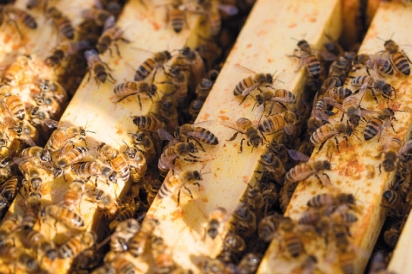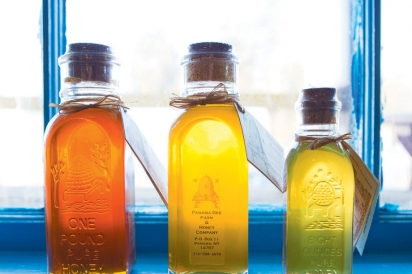SWEET LEGACY: Partnering Beekeeping Traditions with New Management Practices
James Beebe, beekeeper and inventor, voiced this simple truth nearly 150 years ago concerning the fundamental role bees play in honey production: with or without human help, bees have remained nature’s sole producers of this sweet, healthful and favored product since ancient times.
That being said, an education awaits those who see their role as stewards of managed colonies.
Laura and Dennis LaMonica, owners of the Panama Bee Farm and Honey Company, have been learning about beekeeping and honey production for over 15 years. Starting as hobbyists, they studied beekeeping as both an art and science, gathering information from books, fellow beekeepers, seminars, the internet and trial and error. Today they manage 50 colonies (each of which includes between 40,000 and 60,000 bees) at their bee yards in Panama and Bemus Point.
Along the way, the couple has become intrigued by beekeeping history and has found a number of fascinating materials and artifacts related to its beginnings as a thriving industry in our region.
“Between 1870 and 1900, the county was in what has been described as the golden age of beekeeping,” Laura says, with central New York as its “epicenter.” This, the couple explains, was the result of a confluence of available forage (specifically buckwheat) and exceptional transportation to markets because of the railroad.
“There is plenty of evidence that beekeepers in Western New York were participating in the surge of innovations as well as management and marketing,” Laura states. These innovators made it possible for beekeeping to jump from a backyard cottage industry to more commercial production. “There were lots of apiaries [beehives], and the number of colonies they managed was greater than that of most beekeepers we know today,” she adds.
According to “The Golden Age of Beekeeping” by Peter Loring Borst (Beekeepers Journal, December 2013), in 1860 New York produced 2.5 million pounds of honey. By comparison, Borst adds, in 2012 honey production was almost the same, 2.8 million pounds. He continues, “But bear in mind, in 1860 this was all done with manpower and horse-drawn carriages. Produce was shipped downstate via barges.”
In the last decade, the LaMonicas have noticed a resurgence of interest in Western New York, mainly by “sideline” or backyard beekeepers. “Beginner classes fill quickly and local seminars are very well attended,” Laura notes. In addition, there is a thriving market for suppliers of honeybees and beekeeping supplies.
Today, the Chautauqua County Beekeepers Association has about 60 members, but because there is no requirement to register colonies, it is difficult to estimate the actual number of beekeepers.
The Association dates back to 1870 as a place where like minds could gather to share the best ideas of the day. The pride in their labor and industry is apparent as founding member James Beebe boasts, “no better honey is carried to the New York or Chicago markets than the honey from the Chautauqua County.”
Most of the innovators like Cassadaga’s Beebe (who received a patent for his method of winterizing hives) improved on a design originally conceived by Rev. L.L. Langstroth. As Dennis explains, Langstroth “hit the bullseye,” when he developed a hive with moveable frames, which helped keepers better manage their colonies. His prototype was the basis for what is still used today.
Always searching for local artifacts related to honey production, Laura also found a catalog from WT Falconer Co. in Falconer (currently Fancher Chair), which manufactured equipment for beekeeping. “That’s when we realized that things haven’t changed in more than 100 years,” she says.
While beekeeping standards have remained largely unaltered since the 1870s, the LaMonicas admit that there is a learning curve. “The beekeeper is a steward,” says Laura, adding, “colonies require management and there is a responsibility to learn about them and their care.” This includes understanding their life cycle, diseases and when intervention is appropriate. “It’s a relationship which resembles that with other livestock; there is animal husbandry to it.”
Part of stewardship involves checking on the hives. Dennis explains: “Every few weeks you try to assess if there are problems; if there is a dearth, you feed them.” In early spring, nectar may not be available, so the LaMonicas supplement with sugar water, especially if it’s cold and rainy, because bees don’t fly in the rain.
There are other threats as well. Ten years ago, the public was made aware that the number of bees was precipitously falling in what became known as “colony collapse disorder,” which, Dennis says, was erroneously blamed exclusively on pesticides. Although it is still not entirely understood, the cause seems to be multifaceted and at least partly due to a nutritional deficiency resulting from the practice of “monoculture,” or growing only one crop, the stresses of moving bees for pollination, and to some degree pesticides—all of which weaken colonies.
The insect is also prone to bacterial diseases like American foulbrood, which kills them in the brood stage. Bears, which seek the protein in a developing colony, are also a danger to eggs and larvae. But as Dennis states, “The number one problem for both commercial and hobby beekeepers is Varroa mites.” Beekeepers, he says, must actively monitor for this pest, taking steps to reduce the mite load to prevent colony collapse.
While spring feeding is sometimes necessary to support a hive, the preference is always that bees extract food from natural sources, Laura explains. The variety of nectar and pollen sources all affect color and flavor, which make each year and season’s product distinctive. Except for their buckwheat honey with its telltale dark hue and the known proximity of hive to field, the LaMonicas do not label the nectar source on their jars, explaining that unless a pollen analysis is done, there is really no definitive way to know from which plants bees are extracting their nectar (which, they add, is also why certification for organic honey does not exist in the U.S.).
Raw and unfiltered honey is believed to have a number of medicinal properties. According to “Honey and Health: A Review of Recent Clinical Research” (Samarghandian, Farkhondeh and Samini, 2017), studies suggest that honey’s antioxidant, anti-inflammatory and antibacterial properties may be beneficial in treating sore throats, coughs, wounds and moderate burns—and even asthma, cancer and cardiovascular, neurological and gastrointestinal diseases. It is commonly understood that honey should not be given to infants under one year old.
Look for local honey at farmers’ markets and shops throughout Western New York. Products from the Panama Bee Farm and Honey Company are available at Ashville General Store, Chautauqua Bookstore, Herbs R 4 U, Johnson Estate Winery, Lakewood Apothecary, Reverie Creamery and Stedman Coffee Roasters.
“Man cannot gather it, nor has he ever invented a machine by which it may be secured. And here the question very properly arises—how may we best propagate this little industrious honey bee?”
—J.M. Beebe, 1870, The American Bee Journal








